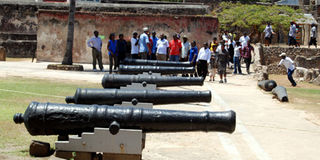Locals come handy in low season industry in low seasons

Local tourists are taken on a tour of the Fort Jesus National Museums. On the foreground are some of the cannons which were used by the British for protection inside the Fort. In 2012, domestic tourism experienced significant growth, a phenomenon attributed to the growing number of middle class Kenyans. PHOTO/FILE
What you need to know:
- Tourists travel from all over the world to delight in the country’s beauty and learn its various cultural practices. Aside from foreigners, locals also take time to sample what the country has to offer.
- Domestic tourism is seen as a tool of facilitating and developing national pride and oneness.
Kenya is not only bestowed with a landscape to behold but also a rich cultural heritage.
Tourists travel from all over the world to delight in the country’s beauty and learn its various cultural practices. Aside from foreigners, locals also take time to sample what the country has to offer.
After attaining independence, there was urgent need to develop the country’s key economic sectors. These were agricultural, industrial and tourism sectors.
Acacia and papyrus
In 1965, the Kenya Tourist Development Corporation was established under an Act of Parliament (Cap 382) of the laws of Kenya.
The corporation’s main focus was offering financial support as well as advisory services for long-term investment in Kenya’s tourism industry.
From the onset, focus was put on ways of drawing more foreign tourists to Kenya. It was soon discovered that local tourists too played a major role in boosting economic growth of the country. As such, domestic tourism was looked at from a whole new angle.
During low seasons of international tourist arrivals, the subsector has become significant in cushioning the industry.
Tourists’ attractions in the country include the flora, fauna, avifauna, heritage sites, national parks and historical sites.
The lion remains the country’s most sought after attraction. Other popular animals include the leopard, elephant, rhino and buffalo, which are collectively referred to as the “Big Five”.
Tourists have a chance to sample Kenya’s diverse flora including forests of euphorbia, baobab and acacia. They also get a chance to see extensive tracts of savannah/ grassland interspersed with groves of acacia and papyrus.
Bird watching is a favourite pastime for many visitors and in this, Kenya never disappoints. The country boasts of over 1,137 bird species meaning that the avifauna segment is well catered for. The bird spices are distributed over the 60 important bird areas in the country.
Heritage sites in the country include Fort Jesus which was designed in the 16th century by Italian architect and engineer Joao Batista Cairato.
It has remained an impregnable fortress of the 16th century due to its unique architecture in the shape of a man looking from above.
There are over 400 Historical Sites in the country ranging from prehistoric fossils, Islamic ruins, petrified forests as well as 16th century Portuguese Forts.
Local authorities are using domestic tourism as a means to enhance unity and cohesion among citizens.
Domestic tourism is seen as a tool of facilitating and developing national pride and oneness.
This was especially evident when the country was recovering from effects of the post-election violence in early 2008.
The National Museums of Kenya has been active in promoting the ethno-cultural diversity of the country.
The institution has done this during the selection of national monuments, in a new touristic development strategy.
During the post-election period, the country’s image as the preferred tourist destination suffered a major blow.
Visitors shunned Kenya after they were issued with travel advisories from their countries. They were told the country is in turmoil and that they should avoid it if they cared for their security.
It took efforts by the Kenya Tourism Board to convince foreign visitors to resume touring the country.
KTB is charged with the responsibility of marketing Kenya as the favourite tourist destination.
The domestic tourists department was operating under the Tourism ministry until early last year when it was moved to be under KTB.
KTB Managing Director Muriithi Ndegwa said then that the department was moved so that local tourists could forward their queries and be assisted faster and better.
In 2012, domestic tourism experienced significant growth, a phenomenon attributed to the growing number of middle class Kenyans.
Amongst all the bed nights spent by East African tourists in hotels, 95 per cent were accounted for by Kenyans.
Ever since the revelation, KTB has stepped up its domestic marketing campaigns to target locals. The board hopes to generate more tourism revenue which is in line with stipulations in the country’s blue print, Kenya Vision 2030.


